| « BACK | HOME » |
 |  |
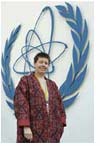 2005 Leadership Award to Dr. Gabriele Voigt. 2005 Leadership Award to Dr. Gabriele Voigt.Dr. Gabriele Voigt is the Director of NAAL, International Atomic Energy Agency's laboratories Seibersdorf, was born in Kempten, Germany,and married to Jens-Jochen Voigt. They have two boys born in 1990 and 1995. Dr. Voight recieved her Ph. D. From University of Bayreuth,1980.Her PhD thesis at the entitled: Ubertragung von Plasmiden aus E. coli auf B. subtilis' (Transfer of plasmids from E. coli to B. subtilis). 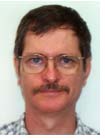 2005 Special Recognition Award for Organizing IWRSA at Vienna to Paul Martin. 2005 Special Recognition Award for Organizing IWRSA at Vienna to Paul Martin.Paul Martin started his professional career in the field of analytical chemistry services for the mining industry, both for exploration and environmental applications. From 1983 until 2004 he lived in the tropical north of Australia, where he carried out research and investigative projects related to environmental management of uranium mining and milling operations. At present he is the head of the Physics, Chemistry and Instrumentation (PCI) laboratory with the IAEA's laboratories at Seibersdorf, Vienna (http://www.iaea.org/OurWork/ST/NA/NAAL/pci/pcimain.php/). Paul's main research work has been in two related areas: development of techniques for measurement of radionuclides in environmental samples by alpha and gamma spectrometry; and study of the behaviour of radionuclides in the tropical environment, both for their use as tracers of environmental processes and for radiological impact assessment purposes. An example was the co-development of a method for measuring all four naturally occurring radium isotopes by alpha spectrometry, and application of this method to studying the behaviour of radium in groundwater in the vicinity of a uranium mine tailings dam. Paul was actively involved in the formation of the South Pacific Environmental Radioactivity Association (SPERA), an organisation which encourages and facilitates communication between scientists working in the South Pacific region. He has been a co-organiser of scientific meetings on behalf of the association, and acted as SPERA President from 2000-2002. 2005 Leadership Award to Dori Ellis click here»  2004 Lifetime Achievement Award to Albert Ghiorso. 2004 Lifetime Achievement Award to Albert Ghiorso.Albert Ghiorso was born in 1915 in California. He went to the public schools in Alameda and then to the University of California where he got a B.S. in 1937 in EE. He worked for a small firm that made communication devices and specialized equipment for emergency services. For the company he made the world's first commercial Geiger counter circuits and this led him to join the Manhattan Project. Once there he became involved in Glenn Seaborg's research program to expand the number of known elements beyond element 94. 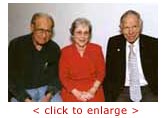 Albert Ghiorso has spent the last 52 years in nuclear science, starting with the Manhattan atomic bomb project. He grew up with atomic energy, learning how to become a hands-on scientist by making some of the pioneer measurements in the field such as discovering that plutonium emitted x-rays as well as alpha particles. He was fortunate to be in a situation where he was exposed to new things all of the time and he will discuss some of his experiences first at the war-time Metallurgical Laboratory at Chicago and then at the Radiation Laboratory which eventually became the Lawrence Berkeley Laboratory. These range from descriptions of the first primitive experiments to the very exotic ones. Much of this was centered around the new element work (he has been involved in the discovery of 12 up to now with the 13th waiting to be confirmed). He has also played the part of detective in proving by measurements in Berkeley that the 1949 Soviet test was a nuclear bomb rather than a nuclear reactor that had blown up. He was the research director for the HILAC and the SuperHILAC and, along with Bob Main and Bob Smith, invented the Omnitron in the early '60s. Proposed the BevaLac concept in 1971. His heavy ion research has led him gradually into new ideas that could lead to a new type of accelerator and thence to practical ways of achieving power from the fusion of light elements. Although he has been "retired" for 14 years he is still active in the laboratory and thus continues to give retirement a bad name! Albert Ghiorso has spent the last 52 years in nuclear science, starting with the Manhattan atomic bomb project. He grew up with atomic energy, learning how to become a hands-on scientist by making some of the pioneer measurements in the field such as discovering that plutonium emitted x-rays as well as alpha particles. He was fortunate to be in a situation where he was exposed to new things all of the time and he will discuss some of his experiences first at the war-time Metallurgical Laboratory at Chicago and then at the Radiation Laboratory which eventually became the Lawrence Berkeley Laboratory. These range from descriptions of the first primitive experiments to the very exotic ones. Much of this was centered around the new element work (he has been involved in the discovery of 12 up to now with the 13th waiting to be confirmed). He has also played the part of detective in proving by measurements in Berkeley that the 1949 Soviet test was a nuclear bomb rather than a nuclear reactor that had blown up. He was the research director for the HILAC and the SuperHILAC and, along with Bob Main and Bob Smith, invented the Omnitron in the early '60s. Proposed the BevaLac concept in 1971. His heavy ion research has led him gradually into new ideas that could lead to a new type of accelerator and thence to practical ways of achieving power from the fusion of light elements. Although he has been "retired" for 14 years he is still active in the laboratory and thus continues to give retirement a bad name!Staff Member, University of Chicago Metallurgical Laboratory, 1942-46; Senior Scientist, Lawrence Berkeley Laboratory, University of California, 1946-82; Senior Scientist Emeritus, ditto 1982-present; Education: B.S. Electrical Engineering, University of California, Berkeley, 1937; honorary Doctor of Science, Gustavus Adolphus College, 1966; American Chemical Society Award for Nuclear Applications in Chemistry, 1973.
Co-Discoverer:  2003 Lifetime Achievement Award to "Mr. WIPP" Wendell Weart. 2003 Lifetime Achievement Award to "Mr. WIPP" Wendell Weart.Wendell Weart has had an extensive 25 year history with the Waste Isolation Pilot Plant as the Project's principal science advisor. Recently retired (2000) as Sandia National Laboratory Fellow, he has over 40 years of expertise in his fields of geotechnical and radioactive waste management research. Dr. Weart's research has concentrated on the physical effects of underground explosions and on nuclear waste disposal in geologic media. He was a geophysicist with the Ballistics Research Laboratory (1956-1959) and Sandia National Laboratory (1959-1975), and Manager of Nuclear Waste Systems (1975-1995) at Sandia prior to becoming Sandia Senior Scientist and a Sandia Fellow concentrating on nuclear waste disposal issues. He is a member of the American Association for the Advancement of Science and of the American Geophysical Union. Dr. Weart earned a B.A. from Cornell College in Geology and Mathematics in 1953 and a Ph.D in Geophysics from the University of Wisconsin in 1961.  2003 Lifetime Achievement Award to Professor Greg Choppin. 2003 Lifetime Achievement Award to Professor Greg Choppin.G.R. Choppin received his Ph.D. from the University of Texas, Austin, in 1953 after which he began postdoctoral research with Glenn T. Seaborg in the new element research group at the Lawrence Radiation Laboratory, University of California. In 1955, he accepted a permanent position in the Laboratory and was one of the four codiscoverers of element 101, Mendelevium. These experiments were the first ones on single atoms as only one atom/hour was made in the cyclotron irradiation. In 1956, he moved to Florida State University as an Assistant Professor of Chemistry. At FSU, he initiated a research program in f-element chemistry, studying both lanthanide (4f) and actinide (5f) behavior. He spent sabbatical years at the Belgian Nuclear Center (Mol) in 1962-63 and at the German Nuclear Center (Karlsruhe) in 1979-80. He has spent shorter periods for research in France, Portugal, Sweden, and Japan. His research has resulted in 400 journal publications and 8 books. A major focus of his research has been the thermodynamics and kinetics of f-element complexation reactions. Since 1975, he has focused attention increasingly on the environmental behavior of the actinide elements. Recognition of his research is reflected in a number of awards among which are the following: American Chemical Society Award in Nuclear Chemistry; Presidential Citation Award, American Nuclear Society; Chemical Pioneer Award, American Institute of Chemistry; Award in Chemical Education, Manufacturing Chemists Association; Award in Rare Earth Chemistry, Rare Earth Society, Japan; Becquerel Medal in Radiochemistry, British Royal Society of Chemistry; Honorary Doctor of Technology, Chalmers University, Sweden; and Alexander von Humboldt Prize, Germany.  2003 Lifetime Achievement Award to Darleane (Christian) Hoffman. 2003 Lifetime Achievement Award to Darleane (Christian) Hoffman.Darleane C. Hoffman currently serves as professor of the graduate school in the Department of Chemistry at the University of California, Berkeley, and as Faculty Senior Scientist in the in the Nuclear Science Division of the Lawrence Berkeley National Laboratory (LBNL). She is an internationally recognized leader in nuclear and radiochemistry and serves on a host of advisory and review committees Her research interests include: rapid chemical separation of short-lived fission products; separation chemistry of lanthanide and actinide elements; search for heavy elements in nature; studies of radionuclide migration in geologic media; studies of the spontaneous fission process; heavy ion reactions; production of new neutron-rich heavy element isotopes; atom-at-a-time studies of the chemical and nuclear properties of the heaviest elements. She has helped organize many national and international symposia in these fields as well as on the status of women in science and presented many invited lectures. She has published more than 240 papers in refereed journals, contributed chapters to many review books on actinides and transactinides and encyclopedias, and co-authored a book, "The Transuranium People-The Inside Story". Darleane Hoffman received her B. S. (1948) and Ph. D. (1951) degrees from Iowa State University, Ames, Iowa. She took a position as chemist at Oak Ridge National Laboratory for a year and then went to Los Alamos Scientific Laboratory in 1953 where she remained until 1984 except for sabbatical leaves in Norway (1964-65) and Berkeley (1978-79). She was Division Leader of the Chemistry-Nuclear Chemistry Division from 1979-82 and of the Isotope & Nuclear Chemistry Division from 1982-1984. She left Los Alamos in 1984 to accept appointments as tenured professor in the Department of Chemistry at the University of California at Berkeley (UCB) and Leader of the LBNL Heavy Element Nuclear and Radiochemistry Group, formerly led by Prof. Glenn T. Seaborg. After she retired from active teaching in 1991, she helped found the Seaborg Institute for Transactinium Science at Lawrence Livermore National Laboratory (LNLL) in 1991 and served as its first Director until 1996 when she "retired" again and became Senior Advisor and Charter Director. As professor of nuclear chemistry and professor of the graduate school in the UCB Department of Chemistry, she has been major professor for 19 Ph. D. and 3 M. S. students and has mentored numerous undergraduate students and postdoctoral fellows. Major accomplishments of Hoffman and her associates include: discovery of plutonium-244 in nature; first observation of enhanced symmetric mass division in spontaneous fission in heavy fermium (element 100) isotopes; first direct proof of electron-capture delayed fission; development of "atom-at-a-time" techniques to investigate chemical properties of heavy elements with half-lives of minutes or less; first aqueous chemistry of element 105; first chemical studies of seaborgium (element 106), bohrium (element 107), and hassium (element 108). Major awards include: NSF Senior Postdoctoral Fellowship, Institute for Atomic Energy, Kjeller, Norway, 1964-65; Guggenheim Fellowship, LBNL, 1978-79; American Chemical Society (ACS) Award for Nuclear Chemistry, 1983; ACS Garvan-Olin Medal, 1990; Norwegian Academy of Science and Letters, 1990; U. S. National Medal of Science, 1997; Fellow, American Academy of Arts and Sciences, 1998; ACS Priestly Medal, 2000; Honorary Doctorates from Clark University, 2000, and University of Bern, Switzerland, 2001; Sigma Xi Proctor Prize for Scientific Achievement, 2003. |
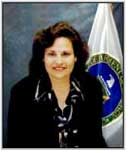 2003 Woman of Achievement Award to Dr. Ines Triay. 2003 Woman of Achievement Award to Dr. Ines Triay.Dr. Ines Triay, Manager of the DOE Carlsbad Field Office, directs all administrative and technical functions of the Waste Isolation Pilot Plant (WIPP). WIPP is the world's first licensed repository for defense related transuranic (TRU) waste. The focus of her work has been on solving the problems associated with radioactive waste in an effort to promote the nuclear future of the United States. Dr. Triay lead a complete re-invention of the National TRU Program and has made WIPP a vanguard geologic repository program, recognized around the world. During her tenure as manager, the number of shipments accepted at WIPP has increased from one or two per week to 25 per week. In order to sustain these shipments, she implemented a complete re-invention of the program by a full-scale re-engineering effort and established the National TRU Waste Complex Corporate Board. Her leadership and ability to influence generator sites' priorities has resulted in an enormous acceleration in waste volumes shipped to WIPP. Prior to her appointment as the Carlsbad Field Office Manager, Dr. Triay was group leader of the Environmental Science and Waste Technology Group at Los Alamos National Laboratory. At that position, Dr. Triay was responsible for multidisciplinary research on decontamination, TRU waste characterization and treatment, environmental chemistry, contaminant transport and remediation, and isotope chemistry for environmental and nuclear issues. Dr. Triay has extensive experience in the fields of environmental science and nuclear chemistry. She holds a BS degree in chemistry and a Ph.D. in physical chemistry, both from the University of Miami. Dr. Triay is a member of numerous professional organizations and has produced some 150 articles, papers, reports and presentations for professional conferences and workshops, as well as major trade publications. She is the recipient of the 2003 Dixy Lee Ray Award from the American Society of Mechanical Engineers (ASME) for her outstanding achievements and significant contributions in the field of environmental engineering. |
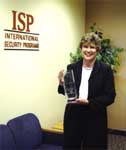 2003 Woman of Achievement and 2005 Leadership Award to Dori Ellis. 2003 Woman of Achievement and 2005 Leadership Award to Dori Ellis.Dori Ellis is The Director of the International Security Programs at Sandia National Laboratories, Albuquerque, New Mexico. She has responsibility for Sandia's international programs in nonproliferation and nuclear materials control; collaborations with more than 100 countries in various training, confidence building, and monitoring activities; arms control analysis; the Cooperative Monitoring Center; and various activities in combating terrorism. Dori was employed by Sandia National Laboratories in June 1978, and earned BS and MS degrees in Mechanical Engineering from the University of New Mexico in 1978 and 1979, respectively. Over her twenty-year career with Sandia, as a staff member and manager, she has also been responsible for non-nuclear testing of weapons; analytical physics; development of electro-mechanical devices for the military and intelligence communities; strategic planning for nonproliferation (for the DOE); nuclear waste management using deep geologic nuclear waste repositories such as the Waste Isolation Pilot Plant (WIPP) and the Yucca Mountain Project (YMP); the Reactor Engineering Technology Center, and Transportation Surety. Mrs. Ellis was awarded the RCS's "Women of Achievement Award" for her leadership in international cooperation on reducing the threat of WMD proliferation and terrorism, and her support of, and contributions to the first International Workshop on the Radiological Sciences and Applications (IWRSA) held during June 16-18, 2003, in Albuquerque, NM. The workshop with the theme of "Issues and Challenges of Weapons of Mass Destruction Proliferation" was sponsored by the RCS, and was attended by seventy (70) international experts, from ten (10) countries, who presented twenty three (23) oral presentations and participated in seven (7) discussion sessions. The Ellis' have five children. Their home adjoins a country club, where they frequently play golf. |
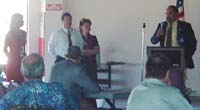 2003 The Presidents Award to Ms. Jessica Hogue, Dr. Don Wall & Dr. Nathalie Wall 2003 The Presidents Award to Ms. Jessica Hogue, Dr. Don Wall & Dr. Nathalie Wall |
| .:: Radiochemistry.org© - all rights reserved ::. |